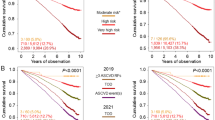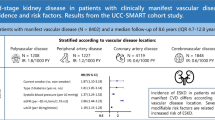Abstract
Competing non-cardiovascular related deaths were not accounted for in the Systematic COronary Risk Evaluation (SCORE) model. In this study we assessed the impact of non-cardiovascular related deaths on the prognostic performance and yield of the SCORE model. 5,752 participants from the Prevention of Renal and Vascular End stage Disease cohort aged 40 years and older who were free of atherosclerotic cardiovascular disease (CVD) at baseline were included. A cause-specific hazards (CSH) CVD-related mortality prediction model that accounted for non-CVD-related deaths was developed. The prognostic performance of this model was then compared with a refitted SCORE model. During a median follow-up period of 12.5 years, 139 CVD and 495 non-CVD-related deaths were reported. Discriminatory performance was comparable between the models (C-index = 0.64). The models showed good calibration although the CSH model underestimated risk in the highest decile while the refitted SCORE model showed overestimation. The CSH model classified more non-events into the low risk group compared to the refitted SCORE model (n = 51), yet it was accompanied by a misclassification of six events into the low risk group. The refitted SCORE model classified more individuals as high risk. However, the potential overtreatment that may result from utilizing the refitted SCORE model, when compared with the CSH model, still falls within acceptable limits. Our findings do not support the incorporation of non-cardiovascular mortality into the estimation of total cardiovascular risk in the SCORE model.



Similar content being viewed by others
References
Perk J, De Backer G, Gohlke H, Graham I, Reiner Z, Verschuren M, Albus C, Benlian P, Boysen G, Cifkova R, Deaton C, Ebrahim S, Fisher M, Germano G, Hobbs R, Hoes A, Karadeniz S, Mezzani A, Prescott E, Ryden L, Scherer M, Syvanne M, Scholte op Reimer WJ, Vrints C, Wood D, Zamorano JL, Zannad F, European Association for Cardiovascular Prevention & Rehabilitation (EACPR), ESC Committee for Practice Guidelines (CPG). European Guidelines on cardiovascular disease prevention in clinical practice (version 2012). The fifth joint task force of the european society of cardiology and other societies on cardiovascular disease prevention in clinical practice (constituted by representatives of nine societies and by invited experts). Eur Heart J. 2012;33:1635–1701.
Stone NJ, Robinson JG, Lichtenstein AH, Bairey Merz CN, Blum CB, Eckel RH, Goldberg AC, Gordon D, Levy D, Lloyd-Jones DM, McBride P, Schwartz JS, Shero ST, Smith SC,Jr, Watson K, Wilson PW, Eddleman KM, Jarrett NM, LaBresh K, Nevo L, Wnek J, Anderson JL, Halperin JL, Albert NM, Bozkurt B, Brindis RG, Curtis LH, DeMets D, Hochman JS, Kovacs RJ, Ohman EM, Pressler SJ, Sellke FW, Shen WK, Smith SC,Jr, Tomaselli GF, American College of Cardiology/American Heart Association Task Force on Practice Guidelines. 2013 ACC/AHA guideline on the treatment of blood cholesterol to reduce atherosclerotic cardiovascular risk in adults: a report of the American College of Cardiology/American Heart Association Task Force on Practice Guidelines. Circulation. 2014;129:S1–45.
van Dis I, Geleijnse JM, Verschuren WM, Kromhout D. Cardiovascular risk management of hypertension and hypercholesterolaemia in the Netherlands: from unifactorial to multifactorial approach. Neth Heart J. 2012;20:320–5.
Brugts JJ, Yetgin T, Hoeks SE, Gotto AM, Shepherd J, Westendorp RG, de Craen AJ, Knopp RH, Nakamura H, Ridker P, van Domburg R, Deckers JW. The benefits of statins in people without established cardiovascular disease but with cardiovascular risk factors: meta-analysis of randomised controlled trials. BMJ. 2009;338:b2376.
Taylor F, Huffman MD, Macedo AF, Moore TH, Burke M, Davey Smith G, Ward K, Ebrahim S. Statins for the primary prevention of cardiovascular disease. Cochrane Database Syst Rev. 2013;1:CD004816.
Jackson R, Lawes CM, Bennett DA, Milne RJ, Rodgers A. Treatment with drugs to lower blood pressure and blood cholesterol based on an individual’s absolute cardiovascular risk. Lancet. 2005;365:434–41.
Mills EJ, Rachlis B, Wu P, Devereaux PJ, Arora P, Perri D. Primary prevention of cardiovascular mortality and events with statin treatments: a network meta-analysis involving more than 65, 000 patients. J Am Coll Cardiol. 2008;52:1769–81.
Conroy RM, Pyorala K, Fitzgerald AP, Sans S, Menotti A, De Backer G, De Bacquer D, Ducimetiere P, Jousilahti P, Keil U, Njolstad I, Oganov RG, Thomsen T, Tunstall-Pedoe H, Tverdal A, Wedel H, Whincup P, Wilhelmsen L, Graham IM. SCORE project group. Estimation of ten-year risk of fatal cardiovascular disease in Europe: the SCORE project. Eur Heart J. 2003;24:987–1003.
Putter H, Fiocco M, Geskus RB. Tutorial in biostatistics: competing risks and multi-state models. Stat Med. 2007;26:2389–430.
Dignam JJ, Zhang Q, Kocherginsky M. The use and interpretation of competing risks regression models. Clin Cancer Res. 2012;18:2301–8.
Koller MT, Raatz H, Steyerberg EW, Wolbers M. Competing risks and the clinical community: irrelevance or ignorance? Stat Med. 2012;31:1089–97.
Allignol A, Schumacher M, Wanner C, Drechsler C, Beyersmann J. Understanding competing risks: a simulation point of view. BMC Med Res Methodol. 2011;11:86.
Rauch G, Kieser M, Ulrich S, Doherty P, Rauch B, Schneider S, Riemer T, Senges J. Competing time-to-event endpoints in cardiology trials: a simulation study to illustrate the importance of an adequate statistical analysis. Eur J Prev Cardiol. 2014;21:74–80.
Koller MT, Leening MJ, Wolbers M, Steyerberg EW, Hunink MG, Schoop R, Hofman A, Bucher HC, Psaty BM, Lloyd-Jones DM, Witteman JC. Development and validation of a coronary risk prediction model for older U.S. and European persons in the Cardiovascular Health Study and the Rotterdam Study. Ann Intern Med. 2012;157:389–97.
Janssen WM, Hillege HL, Pinto-Sietsma SJ, Bak AA, De Zeeuw D, de Jong PE. PREVEND Study Group. Prevention of Renal and Vascular End-stage Disease. Low levels of urinary albumin excretion are associated with cardiovascular risk factors in the general population. Clin Chem Lab Med. 2000;38:1107–10.
Linssen GC, Bakker SJ, Voors AA, Gansevoort RT, Hillege HL, de Jong PE, van Veldhuisen DJ, Gans RO, de Zeeuw D. N-terminal pro-B-type natriuretic peptide is an independent predictor of cardiovascular morbidity and mortality in the general population. Eur Heart J. 2010;31:120–7.
Pinto-Sietsma SJ, Janssen WM, Hillege HL, Navis G, De Zeeuw D, De Jong PE. Urinary albumin excretion is associated with renal functional abnormalities in a nondiabetic population. J Am Soc Nephrol. 2000;11:1882–8.
Hillege HL, Fidler V, Diercks GF, van Gilst WH, de Zeeuw D, van Veldhuisen DJ, Gans RO, Janssen WM, Grobbee DE, de Jong PE. Prevention of Renal and Vascular End Stage Disease (PREVEND) Study Group. Urinary albumin excretion predicts cardiovascular and non-cardiovascular mortality in general population. Circulation. 2002;106:1777–82.
Friedewald WT, Levy RI, Fredrickson DS. Estimation of the concentration of low-density lipoprotein cholesterol in plasma, without use of the preparative ultracentrifuge. Clin Chem. 1972;18:499–502.
Moons KG, Kengne AP, Grobbee DE, Royston P, Vergouwe Y, Altman DG, Woodward M. Risk prediction models: II. External validation, model updating, and impact assessment. Heart. 2012;98:691–8.
Wolbers M, Koller MT, Witteman JC, Steyerberg EW. Prognostic models with competing risks: methods and application to coronary risk prediction. Epidemiology. 2009;20:555–61.
Steyerberg EW, Vedder MM, Leening MJ, Postmus D, D’Agostino RB S, Van Calster B, Pencina MJ. Graphical assessment of incremental value of novel markers in prediction models: from statistical to decision analytical perspectives. Biom J 2014. doi:10.1002/bimj.201300260.
Leening MJ, Vedder MM, Witteman JC, Pencina MJ, Steyerberg EW. Net reclassification improvement: computation, interpretation, and controversies: a literature review and clinician’s guide. Ann Intern Med. 2014;160:122–31.
Ferket BS, van Kempen BJ, Heeringa J, Spronk S, Fleischmann KE, Nijhuis RL, Hofman A, Steyerberg EW, Hunink MG. Personalized prediction of lifetime benefits with statin therapy for asymptomatic individuals: a modeling study. PLoS Med. 2012;9:e1001361.
Wolbers M, Blanche P, Koller MT, Witteman JC, Gerds TA. Concordance for prognostic models with competing risks. Biostatistics. 2014;15:526–39.
Reiner Z. Statins in the primary prevention of cardiovascular disease. Nat Rev Cardiol. 2013;10:453–64.
Conflict of interest
The authors declare that they have no conflict of interest.
Ethical standard
The PREVEND study was conducted in compliance with the Declaration of Helsinki and was approved by all local Ethics Committees. All participants of the study provided informed consent.
Author information
Authors and Affiliations
Corresponding author
Appendices
Appendix 1
See Fig. 4.
Appendix 2: Estimation of 10-year absolute risk of CVD-related mortality based on the refitted SCORE model
-
Step 1 Sex-stratified cause-specific proportional hazards Weibull models were fit for CHD and atherosclerotic non-CHD related deaths using person’s age as time-scale. For a cause of failure k, the models take the form:
$$\lambda_{k} (age;\,p,\alpha ,\beta ,Z) = (p_{k} /\alpha_{k} )(age/\alpha_{k} )^{p} k^{ - 1} \exp (\beta_{k} Z),\quad K = 1,2$$where λ k is the cause-specific hazard function for kth cause of failure, β k represents vector of regression coefficients of each risk factor for kth cause of failure and Z represents a person’s covariate value on the respective risk factor. P and α are sex-specific shape and scale parameters of the baseline hazard function for each cause of failure. Estimates of regression coefficients, β, and parameters of the baseline hazard functions, P and α, associated with these causes of failure are presented in the results (Table 2).
-
Step 2 Estimation of survival functions for CHD and atherosclerotic non-CHD related mortality
$$S_{k} (age) = exp( - \varLambda_{k} (age)),\quad K = 1,2$$where, \(\varLambda_{k} ({\text{age}}) = \exp (\beta_{k} Z)*(({\text{age}})/\alpha_{k} )^{p} k)\)
-
Step 3 Estimation of 10-year survival probabilities for CHD and atherosclerotic non-CHD related deaths
Individual 10-year survival probability for each cause of failure, S k10 , was estimated from the survival functions in step 2 as a conditional probability of surviving up to age + 10 years given that the person survives up to age.
$$S_{k10} (age) = S_{k} (age + 10)/S_{k} (age)$$ -
Step 4 Estimation of 10-year risk of CVD-related mortality
$$Risk_{CVD} = 1 - (exp( - ( - ln((S_{CHD10} ) + ( - ln(S_{non{\text{-}}CHD10} ))))))$$
Estimation of 10-year absolute risk of CVD-related mortality based on the CSH model
-
Step 1 The same cause-specific proportional hazards Weibull models for CHD and atherosclerotic non-CHD-related mortality were used. In addition, a cause-specific hazards model which takes the form of equation in step 1 was fit for non-CVD-related mortality. The regression coefficients, β k , and the parameters of the baseline hazard function for this cause-specific hazards function are presented in Table 2.
-
Step 2 Estimation of overall survival function
The cause-specific hazards functions of CHD, atherosclerotic non-CHD and non-CVD-related mortality were incorporated into the overall survival function, S(age), through;
$$S (age )= exp\left( { - \sum\limits_{k = 1}^{k} {\varLambda _k(age)} } \right),\quad {\text{where}}\,{\text{k}} = 1, 2, 3$$ -
Step 3 Estimation of 10-year absolute risks of CHD and non-CHD related deaths
The absolute risks of CHD and atherosclerotic non-CHD related mortality were estimated as cumulative incidence of each outcome at W = age + 10 years given an individual is still a survivor at age A. The competing risk of non-CVD-related mortality was accounted for in this step as the cumulative incidence functions is determined by the cause-specific hazard functions of all the three causes of failure through the overall survival function S(age). In addition, this also accounts for the competing risk effect of atherosclerotic non-CHD related deaths on CHD-related death and vice versa.
$$I_k(A < T \le A + W,D = K/T > A) = \frac{{\int_{A}^{A + W} {\lambda _k(s)S(s)d(s)} }}{S(A)},\quad {\text{where}}\,{\text{k}} = 1,2$$ -
Step 4 Estimation of 10-year risk of CVD-related mortality
$$Risk_{CVD} = I_{CHD} + I_{non{\text{-}}CHD}$$
Rights and permissions
About this article
Cite this article
Demissei, B.G., Postmus, D., Valente, M.A. et al. Should non-cardiovascular mortality be considered in the SCORE model? Findings from the Prevention of Renal and Vascular End-stage Disease (PREVEND) cohort. Eur J Epidemiol 30, 47–56 (2015). https://doi.org/10.1007/s10654-014-9967-3
Received:
Accepted:
Published:
Issue Date:
DOI: https://doi.org/10.1007/s10654-014-9967-3





